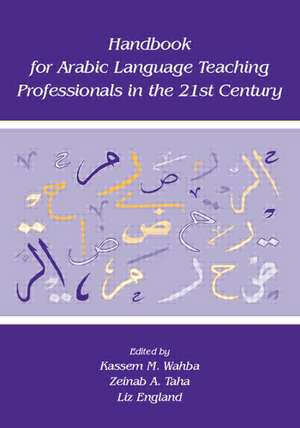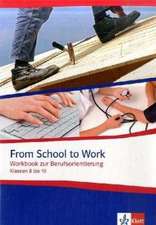Handbook for Arabic Language Teaching Professionals in the 21st Century
Editat de Kassem M. Wahba, Zeinab A. Taha, Liz Englanden Limba Engleză Paperback – 25 apr 2006
The most significant feature of this volume is its pioneer role in approaching the field of Arabic language teaching from many different perspectives. It offers readers the opportunity to consider the role, status, and content of Arabic language teaching in the world today. The Handbook is intended as a resource to be used in building Arabic language and teacher education programs and in guiding future academic research. Thirty-four chapters authored by leaders in the field are organized around nine themes:
- Background of Arabic Language Teaching;
- Contexts of Arabic Language Teaching;
- Communicative Competence in Arabic;
- The Learners;
- Assessment;
- Technology Applications;
- Curriculum Development, Design, and Models;
- Arabic Language Program Administration and Management; and
- Planning for the Future of Arabic Language Learning and Teaching.
Preț: 745.28 lei
Preț vechi: 908.88 lei
-18% Nou
Puncte Express: 1118
Preț estimativ în valută:
142.61€ • 152.50$ • 118.90£
142.61€ • 152.50$ • 118.90£
Carte tipărită la comandă
Livrare economică 17 aprilie-01 mai
Preluare comenzi: 021 569.72.76
Specificații
ISBN-13: 9780805851021
ISBN-10: 080585102X
Pagini: 512
Dimensiuni: 178 x 254 x 26 mm
Greutate: 0.95 kg
Ediția:1
Editura: Taylor & Francis
Colecția Routledge
Locul publicării:Oxford, United Kingdom
ISBN-10: 080585102X
Pagini: 512
Dimensiuni: 178 x 254 x 26 mm
Greutate: 0.95 kg
Ediția:1
Editura: Taylor & Francis
Colecția Routledge
Locul publicării:Oxford, United Kingdom
Public țintă
ProfessionalCuprins
Contents: E.-S. Badawi, Foreword. Preface. Part I: Background. K. Versteegh, History of Arabic Language Teaching. K.C. Ryding, Teaching Arabic in the United States. S. Gass, Models of Second Language Acquisition. P.B. Stevens, Is Spanish Really So Easy? Is Arabic Really So Hard?: Perceived Difficulty in Learning Arabic as a Second Language. Part II: Contexts of Arabic Language Teaching. M.A. Nahla, Egypt: Teaching Arabic to Non-Native Speakers in Alexandria University. M.H. Amara, Israel: Teaching Arabic in Israel. S. Hee-man, F. El-Khazindar, South Korea: Teaching Arabic in Korea. J. Dickens, J.C.E. Watson, Britain and Ireland: Arabic Teaching in Britain and Ireland. N. Anghelescu, Rumania: The Arabic Language at the University of Bucharest. Part III: Communicative Competence in Arabic. D. Wilmsen, What Is Communicative Arabic? K.M. Wahba, Arabic Language Use and the Educated Language User. M. Younes, Integrating the Vernacular With FuSHa in the Arabic-as-a-Foreign-Language Classroom. Part IV: The Learners. R.K. Belnap, A Profile of Students of Arabic in U.S. Universities. R. El Essawi, Arabic Language Learners' Needs: Pedagogical, Cognitive, Affective, and Social. Part V: Assessment. J. Eisele, Developing Frames of Reference for Assessment and Curricular Design in a Diglossic L2: From Skills to Tasks (and Back Again). P. Winke, R. Aquil, Issues in Developing Standardized Tests of Arabic Language Proficiency. Part VI: Technology Applications. E. Ditters, Technologies for Arabic Language Teaching and Learning. V. Stevens, Learner Strategies at the Interface: Computer-Assisted Language Learning. W. Samy, Instructional Media and Learning Arabic. A. Bäbler, Creating Interactive Web-Based Arabic Teaching Material With Authoring Systems. A.N. Madhany, Teaching Arabic With Technology: Word Processing, E-Mail, and the Internet. M. Van Mol, Arabic Receptive Language Teaching: A New CALL Approach. Part VII: Curriculum Development, Design, and Models. M. Abdalla, Arabic Immersion and Summer Programs in The United States. M. Al-Batal, Playing With Words: Teaching Vocabulary in the Arabic Curriculum. K. Brustad, Reading Fluently in Arabic. Z.A. Taha, Towards Pragmatic Competency in Arabic. J. Dickens, Arabic/English Translation and Interpreting Teaching in Britain. Part VIII: Arabic Language Program Administration and Management. M. Sawaie, International Arabic Language Programs. Part IX: Planning for the Future of Arabic Language Learning and Teaching. A. al-Rajhi, A Plan for the Future of Teaching Arabic: A Viewpoint From Within the Arab World. M. Al-Batal, R.K. Belnap, The Teaching and Learning of Arabic in the United States: Realities, Needs, and Future Directions. W.M. Martin, Marketing Arabic as a Second/Foreign Language Program. M. Alosh, H.M. ElKhafaifi, S. Hammoud, Professional Standards for Teachers of Arabic. L. England, Methodology in Arabic Language Teacher Education. Z. Ibrahim, J. Allam, Arabic Learners Heritage Students Redefined: Present & Future.
Notă biografică
Kassem M. Wahba, Zeinab A. Taha, Liz England
Descriere
This landmark volume offers an introduction to the field of teaching Arabic as a foreign or second language. It approaches the field from many different perspectives and provides readers the opportunity to consider the role, status and content of Arabic language teaching in the world today.










